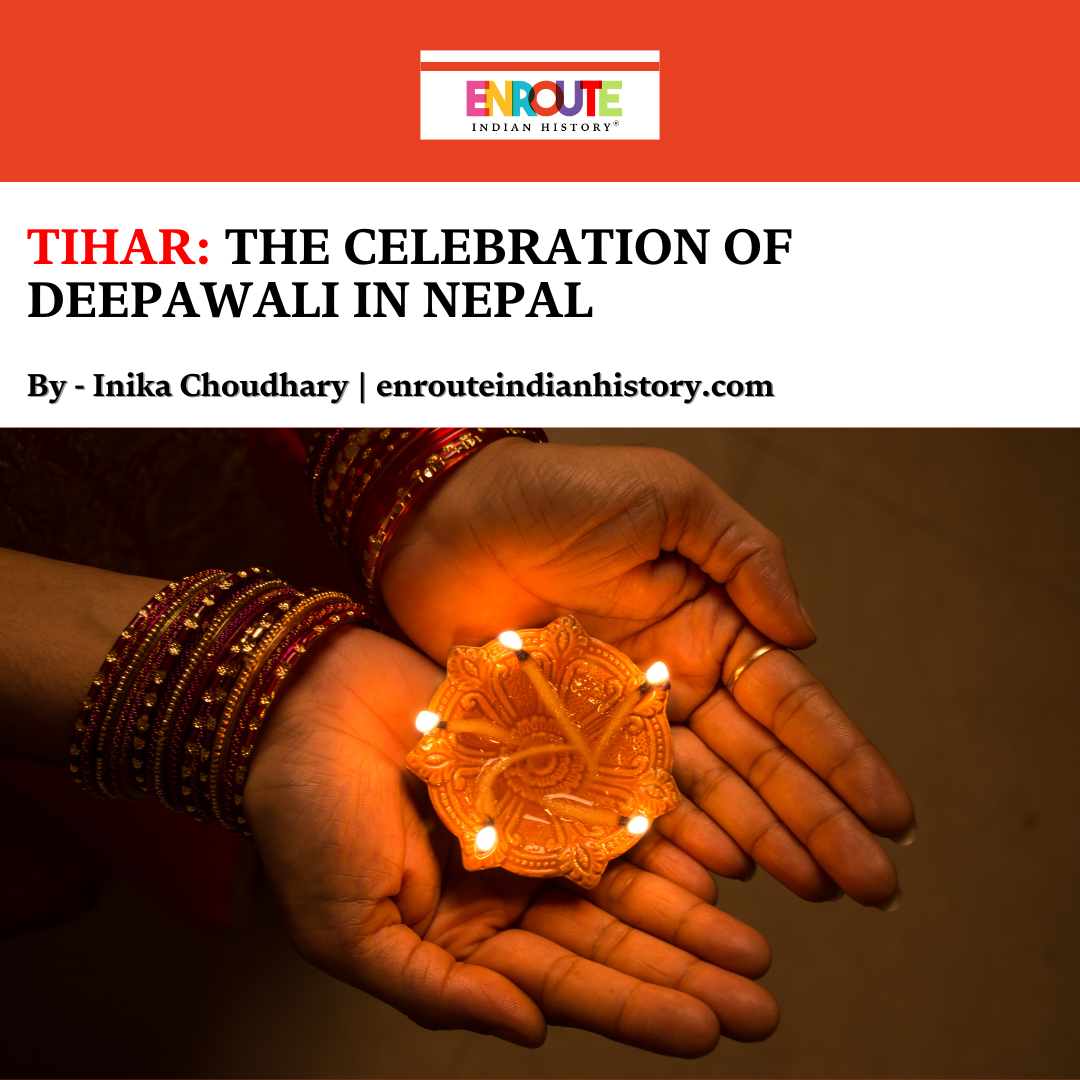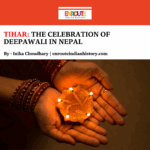
By Chanchal Kale
Festivals illustrate the deep connections between nature, culture, and livelihoods, effectively blurring the boundaries that separate people. In the diverse Indian subcontinent, various cultures celebrate the same festivals, each with its own unique set of rituals. These celebrations help preserve local traditions while also strengthening the bonds among people with similar beliefs. One such example is Diwali which is celebrated as “Tihar” in Nepal and certain regions of north-eastern India.
Tihar, also known as Deepawali or Yamapanchaka, is a five-day festival celebrated by the Hindu community in Nepal. Similar to Diwali, Tihar features vibrant celebrations. Both festivals share cultural roots within Hinduism, celebrating themes of renewal, gratitude, and family bonds. There are notable differences between Tihar and Diwali, particularly in their specific rituals. Tihar emphasizes the reverence of animals, while Diwali in India primarily focuses on divine worship. Diwali commemorates the homecoming of Lord Rama, whereas the legends associated with Tihar centre around Yama, the Hindu God of Death.
Historical Overview
Nepal and India have a shared history. The recorded history of Nepal began with the arrival of the Kiratis in the 7 th or 8 th century BCE from the eastern part of Asia. It was during this time that Buddhism was introduced to the country; it is believed that Buddha and his disciple Ananda visited the Kathmandu Valley and resided in Patan for a period. By 200 CE, Buddhism declined and Hinduism took its place, brought by the Licchavis who came from northern India and defeated the last Kirati king. The Malla dynasty succeeded the Licchavis and reigned for around 550 years.
During these ancient times, particularly under Malla rule, Nepal experienced significant advancements in literature, art, and architecture. The implementation of legal codes inspired by Hindu beliefs brought about a change in governance and societal structure while promoting festivals that are still observed today. Festivals like Tihar could be traced back to this era.
Legends Behind the Celebration
While Diwali in India is majorly a celebration of the Homecoming of Lord Rama after his fourteen years of Vanavasa, the legends associated with the festival of Tihar revolve around Yama, the Lord of Death. Therefore, Tihar is also known as Yamapanchaka. “Yama”, the God of Death, and “Panchak” is significant of the five days of this festival
Tihar has its roots in a particular legend about a girl named Yamuna, who prayed for the health of her sick brother. Yama, the lord of death, was impressed by her devotion and granted her a wish. Yamuna wished for her brother to have a healthy life, eventually saving him from imminent death. Accordingly, Tihar is celebrated to honour the bond of love between brothers and sisters.
In a slightly different version of the story, a Kirati king named Bali Hang, fell severely ill. When Yamaraj came to claim the king’s soul, his sister Yamuna requested Yamaraj to wait until various signs indicated the end of her brother’s life: until the “Tika” on Bali’s forehead faded, the Makhamali (Gomphrena globosa) garland wilted, the water she smeared on her brother’s body dried, or the oil barrier she made around him evaporated. Each year, Yamaraj would send his messengers to check on the Makhamali flowers, but they never wilted. Therefore, Yamaraj granted Bali a long and
healthy life. As a result, sisters worship their brothers during Tihar.
Another legend associated with the festival portrays Yama and Yamuna as brother and sister. Yama, as lord of death, was always busy and Yamuna could not meet him. Yamuna, desperate to meet her brothers, sent a crow, a dog, and a cow as messengers to Yama. Still, Yama could not meet her. After four days of waiting, on the fifth day, Yamuna went to meet Yama herself. Overwhelmed by seeing her brother after a long time, she worshiped him by putting a colourful Tika on his forehead. From this day onwards Tihar has been celebrated.
Rituals and Festivities Associated
During Tihar, the towns are illuminated with diyas, and homes are decorated with patterns of coloured rice and flower petals as a sacred welcome. Unlike Diwali, where five days are dedicated towards the worship of different gods, the five days of Tihar are representative of each day Yamuna waited for her brother Yama. The messengers she sent to her brother are worshipped during these five days.
Kaag (crow) Tihar marks the beginning of the Tihar festival. In Hindu mythology, crows are regarded as messengers of Yama. To appease these messengers and seek protection from death in the coming year, Hindus perform certain rituals and offer grains and seeds to them.
Kukur (Dog) Tihar marks the celebrations of second day of Tihar. People worship dogs by adorning them with garlands. As per Hindu beliefs Yama possessed two pious dogs- Shyama and Sharvara- guarding the doors to hell. They are also considered loyal companions. Mahabharata mentions that Yudhishthira, one of the Panch Pandavas, refused to enter heaven without his dog.
The third day of Tihar honour cows and Goddess Laxmi, emblematic of wealth and prosperity. Nepal has been an agricultural society for centuries making Cows an integral part of their culture. They are revered by Hindu community across the world. Goddess Lakshmi is also worshipped on this day. Homes are cleaned and Diyas are lit to welcome her.
The fourth day celebrates Oxen. This day also features Govardhan Puja, where a dung pile, symbolizing the Govardhan Hill, is worshipped. The puja is to commemorate Lord Krishna’s act of lifting the ‘Govardhan Parvat’ to protect villagers from storms afflicted by the wrath of Lord Indra.
The final day, Bhai Tika, is significant as sisters worship their brothers, strengthening their bonds. Bhai Tika is analogous to the Bhaiduj celebrations during Diwali. The puja begins with sisters creating a boundary around their brothers using “Dubo” (holy grass) infused oil to protect them from death and evil spirits. They then adorn their brothers with a garland made of the Makhamali flowers. Scholar Dinesh Regmi, a professor at Tribhuvan University, notes that dubo does not wither easily and the Makhmali flower does not fade down, symbolizing a long and healthy life.
Next, the sisters apply oil to their brothers’ hair and place a seven-coloured “Tika” on their foreheads. Astrologer Dr. Birendra Prasad Kayastha explains that these Saptarangi tikas reflect sunlight. By putting this Tika on their brother’s forehead, sisters symbolically wish for their brothers to be as powerful as the Sun. Dr. Regmi adds that these colours represent the rainbow, signifying new beginnings.
For those who do not have brothers or sisters, it is customary to visit Ranipokhari Temple in Kathmandu to receive a Tika, as being without one on this day is considered a bad omen. The Ranipokhari Temple is open to the public only on Bhai Tika. Just as Diwali is incomplete without sweets, Tihar is incomplete without folk songs and Sel Roti. During Tihar, young girls and boys visit their neighbourhoods singing Bhailo Deusi songs. In return, they receive money, known as “dakshina”, and Sel Roti, a delightful treat.
Cultural Assimilation
Nepal is a land of diverse ethnic groups, and this diversity significantly influences the celebration of festivals throughout the country, leading to cultural assimilation. Buddhists also celebrate Tihar but with their own traditions. Instead of worshipping Lakshmi, they show their devotion to “Dzambala”, the God of wealth in Tibetan Buddhism.
Dzambala is compared by many scholars to “Yaksha”, subsidiary of King Kuber, symbolic of wealth and prosperity. The Kamasutra of Vatsyayan, dating back to 3 rd century BCE, mentions “Yaksha Ratri” ( Yaksha Night of Lights) even before the association of Goddess Lakshmi with the celebrations of Diwali or Tihar. Yakshas are considered holy spirits by Hindus, Buddhist and Jains, showcasing the importance of
cultural assimilation in formation of the material milieu of the Indian subcontinent.
Complexities and Contradictions
Tihar in Nepal is a festival that highlights the deep respect that Nepalese people have for animals and their cultural traditions. However, it raises questions among modern scholars regarding the dialectics of worshipping and sacrificing animals during the celebrations of Hindu festivals in Nepal. While Tihar honours the holy animals, country’s most significant festival, Dàshain, involves sacrificing animals in honour of Goddess Durga.
Ironically, goat meat plays an important role in the food prepared during Tihar. However, due to the challenging ecological conditions in Nepal, meat has become a primary food source. Considering the significance of meat in the Nepalese diet, the sacrificial ceremony doesn’t seem to be completely irrational. Anthropologist Bishnu Prasad Dahal points out that the animals revered during Tihar often face abandonment throughout the year, reflecting the complexities and contradictions inherent in these celebrations.
Conclusion
Festivals are public expressions of beliefs that enhance a believer’s relationship with God. B.P. Dahal emphasized the interaction between cultural customs, organizations, and institutions when examining the significance of festivals, particularly in the Indian subcontinent. This approach aligns with the ideas of Augusta Comte and Herbert Spencer, who argued that societies should be studied as whole systems of interrelated parts. Therefore, it would be naive to study Tihar without considering the celebrations of Diwali across the subcontinent. Festivals promote social harmony, solidarity, and integration. The celebration of Diwali throughout the region reflects the shared bonds and histories of the people, transcending the concrete boundaries that separate them.
References
1. Lieutenant General Shokin Chauhan, ‘The Dynamics of the India-Nepal Relationship’, United Service Institution of India, 2020
2. Bishnu Prasad Dahal, ‘Dialectics of Sacrificing and worshipping Animals in Hindu Festivals of Nepal’, publisher ‘Scientific Research’, journal ‘Advances in Anthropology’, vol. 10 No. 2, May 2020
3. Bishnu Prasad Dahal, ‘Society, Socialization and Social Order through the Hindu Festivals in Nepal’, Global Journals, Volume 20 issue 5 version 1.0, 2020
4. Jawhar Sircar, ‘ So Many Deepavalis’, Anand Bazar Patrika, October 24 th , 2014
5. Prajapati Puri, ‘About Tihar’, https://www.academia.edu/8744972/About_Tihar
6. ‘Tihar Explained: Five days of celebration’, The Gurkha Welfare Trust, November 7 th , 2023, https://www.gwt.org.uk/news/tihar-explained/
7. Paul Gurung, ‘Tihar: The festival that celebrates the bonds between siblings’, Discovery World Trekking, September 11 th , 2024,
https://www.discoveryworldtrekking.com/blog/Tihar-The-festival-that-celebrates-the-bonds-between-siblings
8. Aimée Knight, ‘ Tihar Festival in Nepal: Days of Dogs, Deities and Income’, Heifer International, October 28 th , 2021, https://www.heifer.org/blog/tihar-festival-in-nepal-days-of-dogs-deities-and-income.html
9. Pasang Dorjee, ‘A Buddhist Family Celebrating Tihar- a Hindu Festival’, The Kathmandu Post, November 5 th , 2021, https://kathmandupost.com/as-it-is/2021/11/05/a-buddhist-family-celebrating-tihar-a-hindu-festival
10. Sabitri Dhakal, ‘Decoding Bhai Tika Symbols’, Nepal Khabar, October 29 th , 2016,
https://nepalekhabar.com/2016/10/70578



















